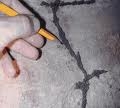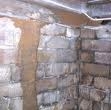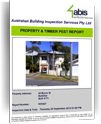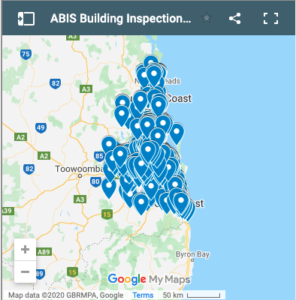To maintain the high level of humidity and temperature necessary, termites leave a thin layer of timber around their activity, concealing their presence.
Termite Activity Can be Detected by:
Termite Shelter Tubes
These originate from the ground crossing barriers such as metal capping to appear on walls and foundations. They protect termites from predators while maintaining high humidity and darkness during their food foraging from the main colony. They are constructed mainly at night when termites are less likely to desiccate. They are often light to dark brown in colour and soil or clay-like in texture. If they are narrow (10mm maximum) they tend to be exploratorily containing workers and soldiers foraging for food. Shelter tubes larger than 50mm width often contain very large numbers of workers and soldiers transporting food and are normally associated with well-established infestation and significant damage.


Subterranean Tunnels
Subterranean species make tunnels through the soil in their search for and transport of food. These tunnels are mostly in the top 20cm of soil, radiating up to 50 meters, although in some soils these may be deeper and radiate further. Tunnels are used by workers for food transport, although soldiers also occur along their length for defence.
Blowholes in Trees
Subterranean termites often have their colonies within trees in the trunk and root crown areas. When alates are ready to leave on their colonising flight, workers cut a longitudinal slit in the trunk as an exit. When the flight is complete, workers seal the hole, over which the tree produces a callus in response to injury.
Earthen Packing
Termites working inside timber may produce large masses of mud-like earthen packing on the surface often seen on foundation walls where they meet flooring or bearers and joists. Workings in buildings associated with several destructive species can be found in a wide range of situations and may or may not be directly part of primary or secondary nests.


Flight Tubes
When a colony is about to release alates for their colonising flight, it often produces small earthen flight tubes projecting horizontally from infested timber. Where these tubes occur, the colony is usually close.
Excavation of Wood
Termites excavate wood leaving a thin outside layer of timber intact – the type of excavation varies from flutings to hollowing to large galleries depending upon the species.


Termite Noises
In buildings infested by termites, an audible tapping may be heard, especially at night. This is caused by soldiers tapping their heads and mandibles on the wood, as a warning signal to others in the colony. This signal is then transmitted by others along the infested woodwork and is mainly heard in subfloor areas.
Odour
Some species of termites e.g. Nasutitermes exitiosus have a characteristic odour.
Presence of Alates
Where alates are found in large numbers caught in spider webs in roof voids and subfloor areas, their flight has occurred nearby and the colony is often very close.
Soldiers and Workers Appearing Singly
Soldiers and workers may enter air-conditioning ducts at night when systems are turned off to be blown into living areas when the system is restarted.
Tree Nests
Some species of termites make their nests in the hollow centre of tree trunks or in the root crown area which makes them difficult to detect. However, the larger the diameter of the tree, the greater the probability of a nest being present, small areas of callus tissue on the trunk also often betray a nest. Trees most often attacked by termites include oaks, peppercorns and many species of eucalypt.


Neighbours
When termites are suspected or found and the source cannot be located, immediate neighbours can often give information on the history of termites in the area.
Collapsed Timber
Termites excavate the internal structure of timber, leaving a thin shell. This protects them from predatory creatures and desiccation. The surface of heavily damaged timbers will often ripple slightly, providing a useful clue to damage. The type of damage to timber is often characteristic of the species, for example, Coptotermes acinaciformis often excavate leaving nothing more than paper-thin parallel sheets, whereas Schedorhinotermes spp. and Nasutitermes spp. create fairly clean excavations, with characteristic plaster-like earthen workings. Depending upon factors such as colony size, location, time of year, and type of timber, termite damage can be considerable within 6 months of their accessing the building.
Termites do not necessarily work through a building in logical sequence – the roof framing may be attacked prior to the rest of the building if the roof framing timber and conditions are more susceptible than other areas. Termites enter walls from foundations and concrete slabs and can destroy structural wall timbers between two levels of a property on their way to warmer roof timbers. This damage may be concealed by the gyprock. Damage may only be evident when walls are opened or there is a collapse or distortion of flooring or internal joinery, which affects the closing of doors and windows. Bearers and joists may also be damaged beneath the flooring.
Damage to roofing timbers often follows an infestation in the walls. The top plates, located immediately above the walls, are often severely damaged although this may be concealed by insulation. Unless a roof is inspected every 6 to 12 months, damage to structural timbers can be severe and extensive. Coptotermes acinaciformis will also damage and penetrate material around electrical and telephone cables, a wide range of plastics, cardboard, polystyrene, leather, cotton and almost any material which obstructs its path.
Other Termite Symptoms
-
Earthen masses on architraves of doors, walls, stairs or skirting boards
-
Blistering, bulging or staining of paint on windows, door architraves and skirting
-
Damp areas on walls may betray the presence of moist earthen material in which termites live
-
Electrical failures causing fire by shorting electrical wiring in subfloor areas and roof cavities
-
Earthen leads up piers over ant caps or concrete slab edges to enter walls on the way to roof
-
Earthen masses in the subfloor area under moist situations such as the bathrooms and kitchens where they act as termite “half-way” properties or in roof cavities and walls
-
Damage to flooring bearers and joists of properties with pier and wall construction
-
Damaged roof timbers especially top plates because of their location above the wall cavity
-
Ivy and other climbing vegetation may conceal evidence such as earthen material on the bark. Plants in contact with the exterior walls of a property or under verandahs and wooden decking are often used by termites to gain access by ascending through the centre of the plant stem
-
Alates which leave on colonising flights may be seen emerging from trees, transmission poles
-
Untreated timber fences which are attacked may be a warning sign;
-
Timber stacked on the ground will attract termites and may conceal a colony
-
Untreated timber used for garden landscaping may provide nesting areas for termites
*Disclaimer: We do not provide professional advice nor services related to termite or other pest extermination services.




